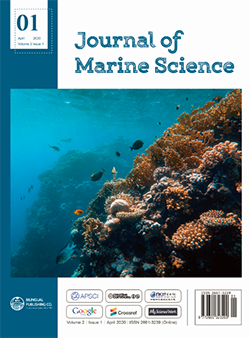The Effect of ENSO on Hydrological Structure and Environment in the South Central Coast – Vietnam
DOI:
https://doi.org/10.30564/jms.v2i1.1215Abstract
ENSO (El Niño-Southern Oscillation) phenomena have impacted on the hydrodynamic regime and environmental factors of the tropical ocean in general. In case of Vietnamese South-Central Waters, impacts of ENSO only focused on issues of changing seasonal wind, seawater temperature anomalies, changing of water masses as the air-sea interaction. Based on several data sets collecting in the period of 2003-2017, new finding of seawater temperature, salinity and environmental factors was identified in the water masses of Vietnamese South-Central Waters. The highest salinity was 35.4 ‰. During the El Nino event, increasing water temperature and salinity caused to move the deeper water masses to be closer to the sea surface than that initial depth in the neutral period. During the La Nina event, the temperature of most water masses reduced by 0.1-3°C, and then these water masses could be affected to the deeper layer. During the phase from strong ENSO event towards the neutral time, nutrient salts of the 4 water masses were lower concentration in the neutral year, causing the lack of phosphorus in sea surface water masses.
Keywords:
Effect of ENSO, Hydrodynamic regime, South Central Coast – VietnamReferences
[1] Barr, C., Tibby, J., Leng, M.J., Tyler, J.J., Henderson, A.C.G., Overpeck, J.T., Simpson, G.L., Cole, J.E., Phipps, S.J., Marshall, J.C., McGregor, G.B., Hua, Q. & McRobie, F.H.. Holocene El Niño–Southern Oscillation variability reflected in subtropical Australian precipitation. Scientific Reports, 2019, 9: 1627.
[2] Dai, A. & Wigley, T.M.L.. Global patterns of ENSO-induced precipitation. Geophysical Research Letters, 2000, 27: 1283-1286.
[3] McPhaden, M.J., Zebiak, S.E. & Glantz, M.H.. ENSO as an Integrating Concept in Earth Science. Science, 2006, 314: 1740-1745.
[4] Soulard, N., Lin, H. & Yu, B.. The changing relationship between ENSO and its extratropical response patterns. Scientific Reports, 2019, 9: 6507.
[5] Freund, M.B., Henley, B.J., Karoly, D.J., McGregor, H.V., Abram, N.J. & Dommenget, D.. Higher frequency of Central Pacific El Niño events in recent decades relative to past centuries. Nature Geoscience , 2019, 12: 450-455.
[6] Zhai, P., Yu, R., Guo, Y., Li, Q., Ren, X., Wang, Y., Xu, W., Liu, Y. & Ding, Y.. The strong El Niño of 2015/16 and its dominant impacts on global and China’s climate. Journal of Meteorological Research, 2016, 30: 283-297.
[7] Chung, T.V. & Long, B.H.. Influence of temperature field and abnormal changes of water level in the South China Sea related to climate change. Journal of Marine Science and Technology, 2016, 16: 44-52.
[8] Dippner, J.W. & Loick-Wilde, N.. A redefinition of water masses in the Vietnamese upwelling area. Journal of Marine Systems, 2011, 84: 42-47.
[9] Xuan, N.B.. Study on the formation and distribution of surface water bodies in the East Sea. Proceedings of the International Conference “Bien Dong 2012”. Nha Trang, Vietnam, 2013: 183-190.
[10] Bai, L.V. & Lanh, V.V.. Characteristics of distribution and structure of saline water in strongly rising waters. Proceedings of the study on the highly developed South Central waters, 1997: 39-48.
[11] Lanh, V.V.. Thermohaline structure and water masses of South China Sea. Collection of Marine Research Works VI, 1995: 25-35.
[12] Lalli, C.M. & Parsons, T.R.. Biological Oceanography: An Introduction. Oxford: Elsevier Publications, 1997.
[13] Long, B.H.. The phenomenon of rising water in Vietnamese waters. Natural Science and Technology Publishing House, 2009.
[14] Doan-Nhu, H., Nguyen-Ngoc, L. & Nguyen, C.-T.. ENSO and anthropogenic impacts on phytoplankton diversity in tropical coastal waters. Progress in Oceanography, 2016, 140: 1-13.
[15] Zhao, H., Zhao, J., Sun, X., Chen, F. & Han, G.. A strong summer phytoplankton bloom southeast of Vietnam in 2007, a transitional year from El Niño to La Niña. PLOS ONE 13, e0189926, 2018.
[16] Vu, T.V., Nguyen, H.T., Nguyen, T.V., Nguyen, H.V., Pham, H.T.T. & Nguyen, L.T.. Effects of ENSO on Autumn Rainfall in Central Vietnam. Advances in Meteorology, 2015, 12.
[17] Thao, P.T.P., Minh-Thu, P., Giam, N.M., Duan, H.D. & Long, B.H.. Relationship between Drought and Rainfall Due to Tropical Cyclone and Depression in Ninh Thuan, Vietnam. Current Journal of Applied Science and Technology, 2018, 30: 1-8.
[18] Mamayev, O.I.. Temperature - Salinity Analysis of World Ocean Waters. Elsevier B.V., 1975: 374.
[19] Thai, T.D., Long, B.H., Tuan, N.V., Cong, N.C., Bac, P.T., Hoi, N.T.T., Thinh, N.D. & Dung, N.T.T.. Some study results on the characteristics and variability of water masses in the south central Vietnam. Journal of Marine Science and Technology, 2018, 18: 1-12.
Downloads
Issue
Article Type
License
Copyright and Licensing
The authors shall retain the copyright of their work but allow the Publisher to publish, copy, distribute, and convey the work.
Journal of Marine Science publishes accepted manuscripts under Creative Commons Attribution-NonCommercial 4.0 International License (CC BY-NC 4.0). Authors who submit their papers for publication by Journal of Marine Science agree to have the CC BY-NC 4.0 license applied to their work, and that anyone is allowed to reuse the article or part of it free of charge for non-commercial use. As long as you follow the license terms and original source is properly cited, anyone may copy, redistribute the material in any medium or format, remix, transform, and build upon the material.
License Policy for Reuse of Third-Party Materials
If a manuscript submitted to the journal contains the materials which are held in copyright by a third-party, authors are responsible for obtaining permissions from the copyright holder to reuse or republish any previously published figures, illustrations, charts, tables, photographs, and text excerpts, etc. When submitting a manuscript, official written proof of permission must be provided and clearly stated in the cover letter.
The editorial office of the journal has the right to reject/retract articles that reuse third-party materials without permission.
Journal Policies on Data Sharing
We encourage authors to share articles published in our journal to other data platforms, but only if it is noted that it has been published in this journal.




 Pham Xuan Duong
Pham Xuan Duong


